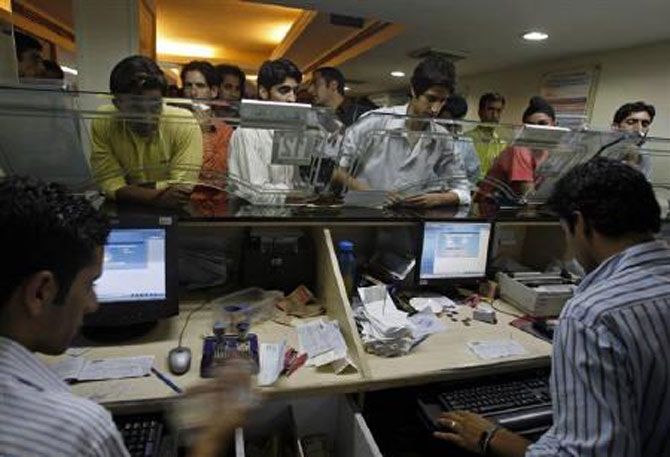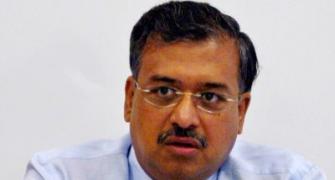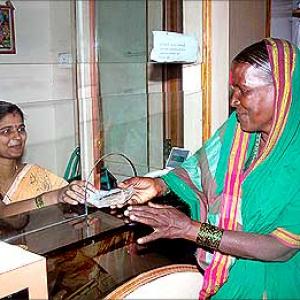The RBI has created a stunted business model by which payment banks are supposed to shoulder the noble objective of financial inclusion without being able to make much money, says Debashis Basu.
 To the great consternation of the wise men of the Reserve Bank of India (RBI) and proving cheerleading commentators wrong, applicants to set up payment banks are dropping out one after another.
To the great consternation of the wise men of the Reserve Bank of India (RBI) and proving cheerleading commentators wrong, applicants to set up payment banks are dropping out one after another.
Cholamandalam Finance, run by the level-leaded Murugappa group from the South, was the first to drop out.
Then it was the flamboyant Dillip Shanghvi and his brother-in-law Sudhir Valia, who seemed hell-bent on wasting a small part of their considerable wealth on banking - after wind farms (investing in Suzlon) and finance (Fortune Financial) - but they too have sobered up and decided to drop the payment bank idea.
Finally, Tech Mahindra, a software company, has gone out of the race.
Readers of this column will not be surprised. In November 2014, when the RBI announced that it would license a new kind of banks called payment banks, I was perhaps the lone sceptical voice in the face of this shining new idea.
One commentator declared that this is "a huge radical step toward financial inclusion".
Another saw 100 payment banks blooming - from all the telecom companies to retailers like Flipkart, Snapdeal and Reliance, or India Post, or even the Railways and oil companies.
Businessmen too were excited with the payment bank idea, as they always are, when regulators seem to open the cookie jar just a little bit to allow a few hands to dip into it.
I had no doubt that there would be many applications to start payment banks since banking is one of few businesses where demand far exceeds supply.
Even then the RBI got only 41 applications - a far cry from the 100 banks that commentators dreamt about.
But I was categorical in saying that the payment bank idea, a strange animal midwifed in the ivory towers of the RBI, was likely to be dead on arrival.
"Cold calculations show that these banks are unviable as a standalone business," I wrote in this column earlier. "Payment banks are far from being banks. One, they will make no money on the spread between deposit and investment. Indeed, on the deposit side, they will need to pay consistently higher interest to attract deposits. Two, they won't be allowed to lend, depriving them from of the main source of a bank's revenue. It's like saying, you can start a newspaper as long as you don't accept advertisements."
With three of the 11 having dropped out, RBI officials are red-faced.
Deputy Governor S S Mundhra - who has been a banker, not a theoretical expert like others in the RBI, and therefore should know better - is strangely upset.
He wishes the RBI could inflict a penalty on the dropouts like a teacher can do to class-cutting students.
No, he still does not think there is anything wrong in the structure of payments banks, as conceived by a group headed by Nachiket Mor.
What is wrong with the payments bank idea?
The RBI has created a stunted business model by which payment banks are supposed to shoulder the noble objective of financial inclusion without being able to make much money.
They also forgot that collecting deposits is only one half of "financial inclusion".
The other half is lending to those who do not have access to formal credit. But payment banks cannot lend.
They can potentially make money by charging 200 million migrant workers for payments and transfers.
Large, profitable, existing commercial banks either don't do this efficiently or loot them for this service.
But payment banks won't find it easy to execute this either, as I had pointed out.
This is because the licensing Luddites in the RBI will not allow telecom companies to use their network.
The RBI regulation does say "cash-out can also be permitted at Point-of-Sale terminal locations,"; it also says "the other financial and non-financial services activities of the promoters, if any, should be kept distinctly ring-fenced."
So, the ready network of a billion cellphone users, 90 per cent prepaid, being served by millions of touch points, cannot be used right now.
So, how will the cash from a Mumbai tax driver reach his wife in Gorakhpur?
Since nobody has explained it, I assumed it would be the same slow and terribly expensive branch network plus ATMs at existing banks.
Or it could be the Unified Payments Interface of the National Payments Corporation, which will reduce the margin on the remittance business anyway.
The whole business of banking services and payment systems is ripe for creative disruption, which will immeasurably help customers.
But then, there is the RBI standing in the way. In one part of India, mainly e-commerce, private enterprise is free to adopt the latest technologies, which has brought amazing convenience to citizens. In another part, regulators tie-up businesses in knots and then ask them to run, as has happened in case of payments banks. The payments-banks fiasco once again shows, how little has changed in the RBI under a supposedly go-getting governor.
Photograph: Reuters
The writer is the editor of www.moneylife.in









.jpg)
